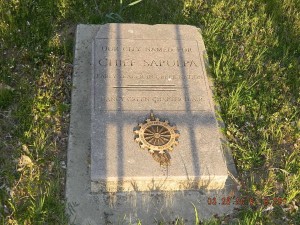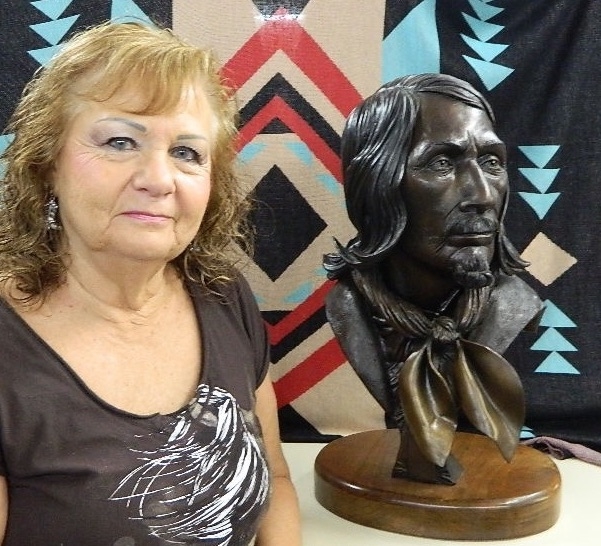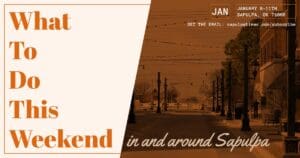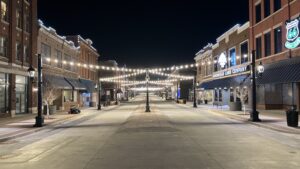Featured Image: Mary Branscum, widow of James Branscum, poses with bust he created of Chief Sapulpa, of whom the town was named. The bust currently is on display at Farmers’ Feed, 121 N. Main where Ms. Branscum is employed. A carved wooden statue that once stood in the courtyard of Sapulpa City offices now stands stately on the second floor of City Hall. Clayton Coss is its artist. At the insistence of historian, the late Jim Hubbard, the statue was preserved and moved inside. He had hoped the bronze also would eventually be on display there.
What started out as a request from an aging historian may be the crowning work of Southwest artist and Drumright native, the late James Branscum — especially locally.
The only public display of a bust of “Chief Sapulpa” that Branscum sculptured after meeting local historian Jim Hubbard is on the counter at Farmers’ Feed Store. The nearly life-sized bronze head and face gets lots of attention. Many local folk have viewed it.
There’s quite the story surrounding the bust — some romance, some tragedy, a fire, the deaths of both the historian and the artist — and this bit of irony. “Chief” Sapulpa (and yes, we know he wasn’t the Chief of the Muscogees) ran a trading post business not so much unlike that of the Johnston family at 121 North Main.

Of course the intent of both Hubbard and Branscum was for the artwork to be exhibited at Sapulpa City Hall or the Sapulpa Historical Museum — maybe both and at a bank or two.
But the molds are gone now — destroyed in a fire when the foundry at Pawhuska burned. Fifteen busts had been planned.
Mary Branscum, former wife of the artist, possesses one of maybe no more than three of the bronze castings. She thought it at least deserved viewing outside of her home and hopes someday it can be at a public venue.
To date, no one has covered the expenses. Originally, according to Ms. Branscum’s understanding, Hubbard had hoped a committee would come up with funds to pay for its creation. Hubbard decided to go it alone as he gained public support for the project but passed before the bust was finished. Although no formal commissioning was secured, Branscum apparently had done so much work on the project he decided to follow through with the bust.
Hubbard sought out Branscum when he was doing an art exhibit at Sapulpa’s American Heritage Bank in 1996. Hubbard himself dabbled in art — drawings and paintings. He asked Branscum if he would consider producing a statue of Chief Sapulpa. Hubbard had in mind a more permanent fixture than that at City Hall — the bigger-than-life wooden rendition carved by famous chain saw artist Clayton Coss. Hubbard did like the idea of Chief Sapulpa standing “vigilant” holding his rifle and a lantern.
Branscum opted for the bust and produced the drawings from historical photos. The work was done 2005-2007. Some of the artwork was performed before the public at Wal Mart.
Branscum was then diagnosed with Castleman’s Disorder, a rare disease of the lymph nodes and related tissues. It was first described by Dr. Benjamin Castleman in the 1950s, thus the name. At any rate, it took the artist’s health and eventually his life.
Mary Branscum also blames the disease and issues related to it for ending their marriage. The two had gotten re-acquainted 30 years after they were teenage sweethearts. In fact, she was 16 and a student at Mounds in 1964. He was 18 and at Drumright. They planned to elope to Arkansas and be married.
Mary’s dad discovered the plans and put a stop to them.
“He (her father) was just looking out for me,” Mary said.
Jim soon left for Phoenix where he would go to art school and eventually dedicate his life to art. But as fate would play out, after both had married, raised families and divorced, they got together again and “ran off” to Arkansas and were wed in front of the State Capitol at Little Rock.
Branscum had long owned and operated studios in Arizona. Back in Oklahoma, he operated an art studio from home in Kellyville until the disease took its toll and “he didn’t feel like doing anything.” He died in 2015.
Branscum was well-known for his pencil drawings. He had taken his landmark “Aging in America” project from his Arizona studio across America. That project along with his life and work were featured in magazines and newspapers across the country.
Branscum was often acknowledged as the first non-Native American artist to exhibit major Indian-inspired pieces in the marketplace. His pencil art included 28 Southwestern tribal leaders is subjects. Perhaps better known than his Chief Sapulpa bust is that of country music legend Waylon Jennings.
—
Branscum found success marketing his own work, that of which has been featured in numerous exhibitions and magazines across the United States. For years he ran the Jim Branscum Arts Studio at the Scottsdale Center for the Arts, which also included a gallery. Branscum closed the studio in the mid-1990s as he trekked across the country for his “Aging in America” project: a landmark series of drawings that captured a cross-section of America’s elderly from many racial and ethnic backgrounds. In addition to large-scale endeavors like “Aging in America,” Branscum also was often commissioned to sculpt pieces like a Korean War Memorial located in Phoenix.











